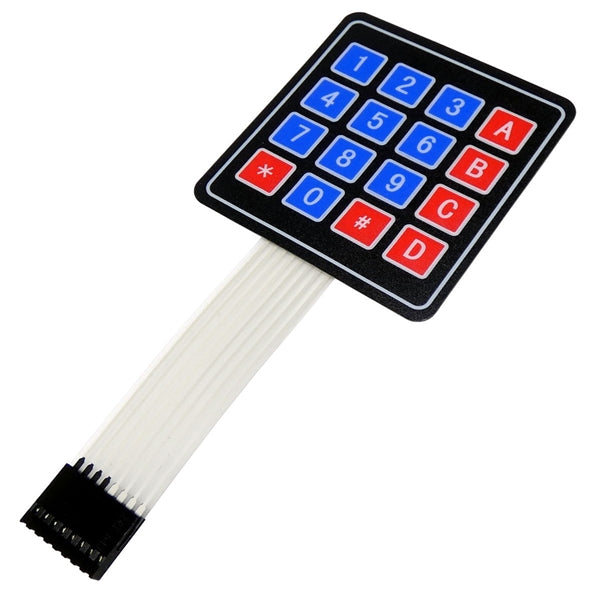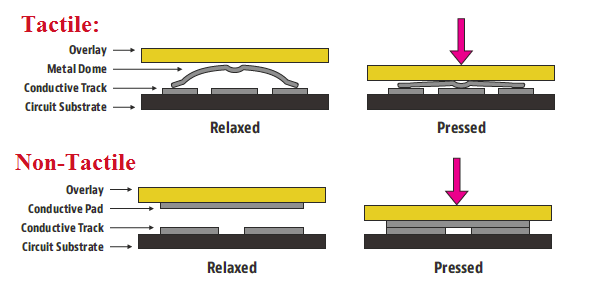Recognizing the Significance of Membrane Switches in User User Interfaces
Membrane buttons are important components in the layout of efficient interface, promoting not only functionality yet likewise enhancing aesthetic appeal and individual interaction. Their special features, such as resistance to adjustable layouts and ecological aspects, make them suitable for a varied selection of applications across numerous markets. As we discover the future trends and different benefits related to Membrane technology, it ends up being clear that these buttons are greater than just elements; they stand for a convergence of advancement and usefulness. The implications of this modern technology on user experience deserve checking out additionally.
What Are Membrane Switches?

The spacer layer, which includes sticky buildings, permits for the separation of the circuit layer from the overlay, ensuring that the button stays in a non-activated state till pressed. When pressure is put on the overlay, it presses the spacer layer, bridging the space and completing the circuit in the underlying layer. This style not only minimizes the physical area needed for traditional mechanical buttons yet likewise enhances the durability of the device, as Membrane switches are usually resistant to dust, wetness, and other ecological elements.
Typically located in applications varying from consumer electronic devices to clinical devices, Membrane switches are indispensable to contemporary technology, supplying a efficient and user-friendly user interface that aligns with modern design needs.
Advantages of Membrane Switches
While many switch modern technologies exist, Membrane Switches deal unique benefits that make them particularly preferable in numerous applications. One of the key benefits of Membrane switches is their portable style, which enables space-saving implementations in tools where real estate is limited. Their slim profile not just boosts aesthetic allure however additionally facilitates light-weight building and construction.
One more significant advantage is their resistance to ecological elements. Membrane switches are typically secured versus wetness, dirt, and contaminants, making them excellent for use in demanding environments, such as clinical devices and commercial tools. This sturdiness extends the lifespan of the switch, minimizing upkeep prices and enhancing reliability.
Furthermore, Membrane buttons can be customized to meet particular style demands, integrating one-of-a-kind graphics and colors that enhance user communication. Their tactile responses options can also be tailored to offer a rewarding individual experience. Furthermore, Membrane switches are affordable, particularly in high-volume applications, as they can be generated successfully.
Applications in Numerous Industries

In the customer electronic devices field, Membrane buttons are common in tools such as microwaves, cleaning equipments, and remotes. Their responsive responses and aesthetic alternatives boost user experience while offering a sleek, modern-day look. In addition, vehicle manufacturers make use of Membrane buttons in dashboard controls and infomercial systems, where space is restricted, and individual engagement is important.
Furthermore, the commercial industry leverages Membrane switches in control panels for equipment and devices, permitting instinctive operation in commonly severe environments. Their resistance to chemicals and dampness ensures long life and integrity in these applications. Overall, the versatility of moved here Membrane Switches adds substantially to their prevalent use, making them indispensable in different technological domains.
Style Factors To Consider for Membrane Switches

When making Membrane buttons, numerous crucial factors to consider have to be thought about to guarantee ideal capability and customer experience. Firstly, the selection of products is crucial; choosing long lasting, top quality substratums can boost the button's longevity and resistance to environmental elements such as wetness and temperature variations.
Second of all, the layout of the visuals overlay need to focus on quality and convenience of usage. Icons and text must be legible, and the layout should facilitate instinctive interaction (membrane switches). Additionally, responsive responses is necessary; including a tactile dome or other mechanisms can improve the individual experience by offering physical confirmation of activation
An additional crucial element is the switch's electrical performance. Developers should ensure that the conductive traces are effectively created to reduce resistance and avoid signal disturbance. This involves assessing the called for actuation force and making certain compatibility with the electronic elements they will user interface with.

Future Fads in Membrane Technology
As technology remains to breakthrough, Membrane switches are positioned to progress substantially, driven by developments in products and manufacturing methods. One emerging pattern is the consolidation of innovative materials, such as adaptable substratums and conductive inks, which improve durability and minimize the total weight of Membrane switches. These products not only improve the responsive feedback but likewise enable the design of buttons that can withstand harsher ecological problems.
Additionally, the combination of touch-sensitive modern technologies is transforming conventional Membrane Switches right into even more interactive customer interfaces. Capacitive touch sensing units installed within Membrane button panels can offer a more user-friendly and receptive customer experience, aligning with the growing need for streamlined, contemporary designs in customer electronics.
In addition, improvements in printing strategies, such as digital and 3D printing, enable quick prototyping and modification of Membrane buttons. This adaptability permits manufacturers to respond quicker to market demands and customer choices.
Last but not least, sustainability is coming to be a considerable emphasis, with suppliers discovering eco-friendly materials and procedures. As these fads unravel, the future of Membrane innovation guarantees improved performance, visual allure, and ecological duty, solidifying their function in advanced user interfaces throughout numerous markets.
Final Thought
To conclude, Membrane Switches stand for an important component in the layout of interface, incorporating capability with visual flexibility. Their advantages, consisting of toughness and resistance to ecological elements, make them suitable for varied applications across various sectors. Moreover, thoughtful design factors to consider improve customer communication and experience. As developments in technology proceed, the evolution of Membrane switches is anticipated to additional improve individual interfaces, driving innovation and enhancing usability in an increasingly intricate technological landscape.
Membrane switches are important parts in the design of efficient user interfaces, helping with not just functionality yet also improving visual allure and user interaction.Membrane Switches offer as an important element in numerous user interfaces, helping with a smooth communication between users and electronic gadgets.While countless switch technologies exist, Membrane Switches deal unique benefits that make them specifically preferable in different applications.Additionally, Membrane buttons can be tailored to meet specific design demands, integrating special graphics and shades that boost customer communication.In verdict, Membrane Switches represent a crucial element in the style of customer interfaces, incorporating capability with visual adaptability.